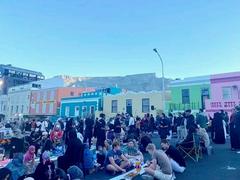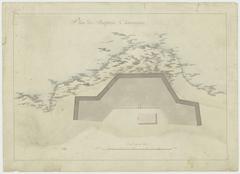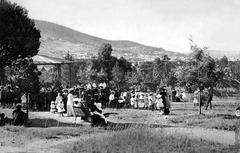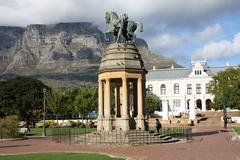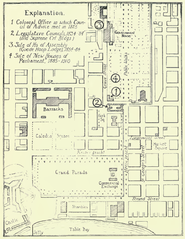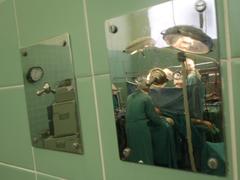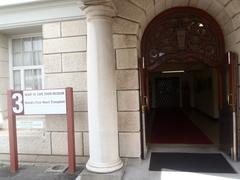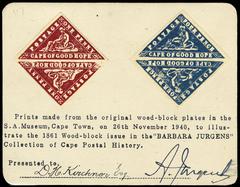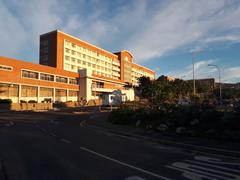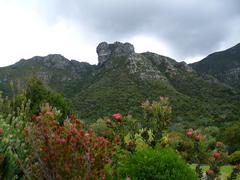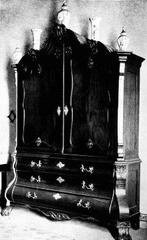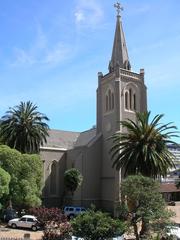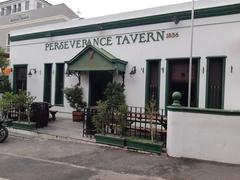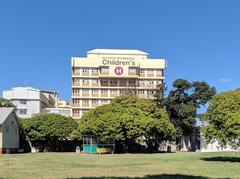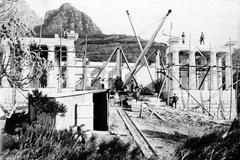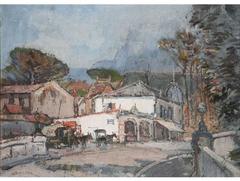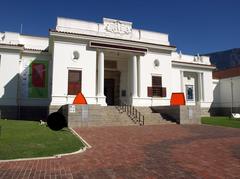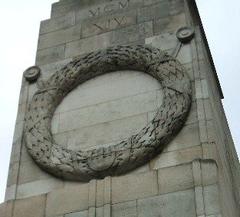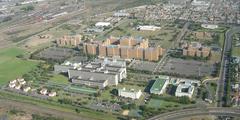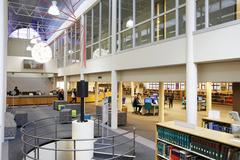Egyptian Building Cape Town: Visiting Hours, Tickets & Historical Guide
Date: 14/06/2025
Introduction
The Egyptian Building stands as a unique architectural and cultural landmark in Cape Town. Located on the University of Cape Town’s Hiddingh Hall Campus, this iconic structure is the oldest purpose-built university building in South Africa and a rare example of Egyptian Revival architecture in Africa. Completed in 1841, it was originally constructed for the South African College, the forerunner of UCT, and now houses the Michaelis School of Fine Art. Its monumental design, adorned with Egyptian motifs, reflects the institution’s commitment to knowledge and enlightenment.
This comprehensive guide covers the Egyptian Building’s historical context, architectural significance, visiting hours, ticket and accessibility information, as well as tips for making the most of your visit and exploring nearby attractions. For more details, consult official university and heritage resources (SA History Online, Artefacts, UCT Michaelis Facilities).
Table of Contents
- Historical Background & Architectural Context
- Significance in South African Architecture
- Structural & Interior Features
- Symbolism & Heritage Status
- Visiting Hours, Admission & Accessibility
- Tours, Events & Art Engagement
- Location, Access & Nearby Attractions
- Visitor Tips & Frequently Asked Questions
- Visuals & Media Resources
- Conclusion & Travel Tips
- References & Further Reading
Historical Background & Architectural Context
The Egyptian Building was designed by architect John Moffat in the Egyptian Revival style, characterized by battered (sloping) walls, lotus-bud capitals, and stylized hieroglyphics. Its imposing façade, with monumental pylons and symmetrical design, was intended to evoke the grandeur of ancient temples and symbolize the pursuit of wisdom—an apt motif for South Africa’s earliest higher education facility (SA History Online, Artefacts).
Originally home to the South African College, the building marked the beginning of formal academic instruction in the region. Its legacy endures as part of UCT’s Hiddingh Hall Campus, where it continues to foster creativity and scholarship.
Significance in South African Architecture
The Egyptian Building is not only the country’s oldest university structure but also its most significant example of Egyptian Revival architecture—a style seldom employed in colonial Africa. Its presence reflects the global architectural trends of the 19th century and the Cape’s colonial elite’s desire to associate with European intellectual traditions. The building’s enduring legacy is evident in its continued use and well-preserved condition (Artefacts, The South African).
Structural & Interior Features
Constructed with robust masonry, the Egyptian Building’s battered walls provide both aesthetic distinction and structural stability. The entrance is flanked by monumental pylons decorated with sun disks and lotus motifs, while interior features include high ceilings, large sash windows, and decorative moldings reminiscent of ancient Egyptian design. Originally, a central hall was used for lectures, with flanking classrooms and subsequent expansions to accommodate academic growth. Many original elements remain, and the space now houses studios, galleries, and offices for the Michaelis School of Fine Art (Artefacts, UCT Michaelis Facilities).
Symbolism & Heritage Status
The Egyptian Revival style was selected to convey durability, enlightenment, and a connection to the cradle of civilization. As a National Monument, the Egyptian Building benefits from ongoing restoration and conservation efforts, preserving its architectural integrity and cultural value for future generations (Artefacts).
Visiting Hours, Admission & Accessibility
- Opening Days: Monday to Friday (closed on weekends and public holidays)
- Hours: 9:00 AM – 5:00 PM (some campus facilities open from 8:00 AM)
- Admission: Free entry for all visitors
As an active academic facility, certain interior spaces may be restricted during university events or classes. The building is partially wheelchair accessible, with ramps at the main entrance; for specific accessibility needs, contact the university in advance (UCT Michaelis Facilities).
Tours, Events & Art Engagement
- Guided Tours: Available by prior arrangement through the Michaelis School of Fine Art (Michaelis Contact). These tours offer in-depth insights into the building’s history, design, and current role.
- Self-Guided Visits: Public spaces can be explored independently during opening hours; some areas may be inaccessible during academic sessions or exhibitions.
- Art & Exhibitions: The Michaelis Gallery hosts rotating exhibitions, including the annual graduate showcase, and the campus frequently offers lectures, workshops, and performances (Michaelis Gallery).
- Special Events: Consult the UCT events calendar for upcoming exhibitions and cultural programming.
Location, Access & Nearby Attractions
- Address: 31–37 Orange Street, Gardens, Cape Town, 8001
- Transport: Accessible via MyCiTi bus, taxi, or rideshare. Limited street parking is available nearby.
- Safety: The area is generally safe during daylight hours; remain vigilant and avoid walking alone after dark (Travellers Worldwide).
- Nearby Attractions:
- Company’s Garden: Historic park and museum precinct
- Iziko South African National Gallery
- South African Museum
- National Library of South Africa
- Bo-Kaap neighborhood
Visitor Tips & Frequently Asked Questions
- Best Time to Visit: Weekday mornings for a quieter experience. Spring (September–November) and autumn (March–May) offer mild weather.
- What to Bring: Light jacket for variable weather, camera for architectural details, and comfortable walking shoes.
- Accessibility: Some areas have steps or uneven floors; assistance is available at the main entrance.
- Photography: Allowed in public areas; restrictions may apply during exhibitions—respect all posted signage.
FAQ
Q: Is there an admission fee?
A: No, entry is free.
Q: What are the visiting hours?
A: Monday to Friday, 9:00 AM to 5:00 PM. Closed weekends and public holidays.
Q: Are guided tours available?
A: Yes, by prior arrangement through the Michaelis School of Fine Art.
Q: Is the building wheelchair accessible?
A: Partially. Contact the university for detailed information.
Q: Can I take photographs inside?
A: Yes, in most public spaces unless otherwise indicated.
Visuals & Media Resources
Enhance your visit by exploring photo galleries and virtual tours available through UCT and tourism platforms. Look for high-quality images of the façade, interior features, and exhibitions, with descriptive alt text for accessibility (e.g., “Egyptian Building façade at University of Cape Town,” “Michaelis Gallery exhibition artwork”).
Conclusion & Travel Tips
The Egyptian Building offers a rare opportunity to experience South Africa’s architectural, educational, and artistic heritage in one captivating site. With free admission, central location, and vibrant programming, it is an essential stop for anyone exploring Cape Town’s historical and cultural landscape. Plan your visit in advance, check for current exhibitions, and take advantage of nearby attractions for a rich, immersive experience.
Ready to discover more? Download the Audiala app for curated audio tours, event updates, and travel tips. Stay connected with UCT and Michaelis School of Fine Art for the latest on exhibitions and events.
References & Further Reading
- Visiting the Egyptian Building in Cape Town: Hours, Tickets, and Historical Insights, 2025, SA History Online (SA History Online)
- Visiting the Egyptian Building in Cape Town: History, Architecture, and Visitor Information, 2025, Artefacts (Artefacts)
- Visiting the Egyptian Building Cape Town: Hours, Tours, and Cultural Highlights, 2025, University of Cape Town Michaelis School of Fine Art (UCT Michaelis Facilities)
- Architectural Heritage of Cape Town: A Stroll Through History, 2025, The South African (The South African)
- Cape Town Travel - Heritage Sites in Cape Town and Surrounds, 2025, Cape Town Tourism (Cape Town Travel - Heritage Sites)
Internal Links:

